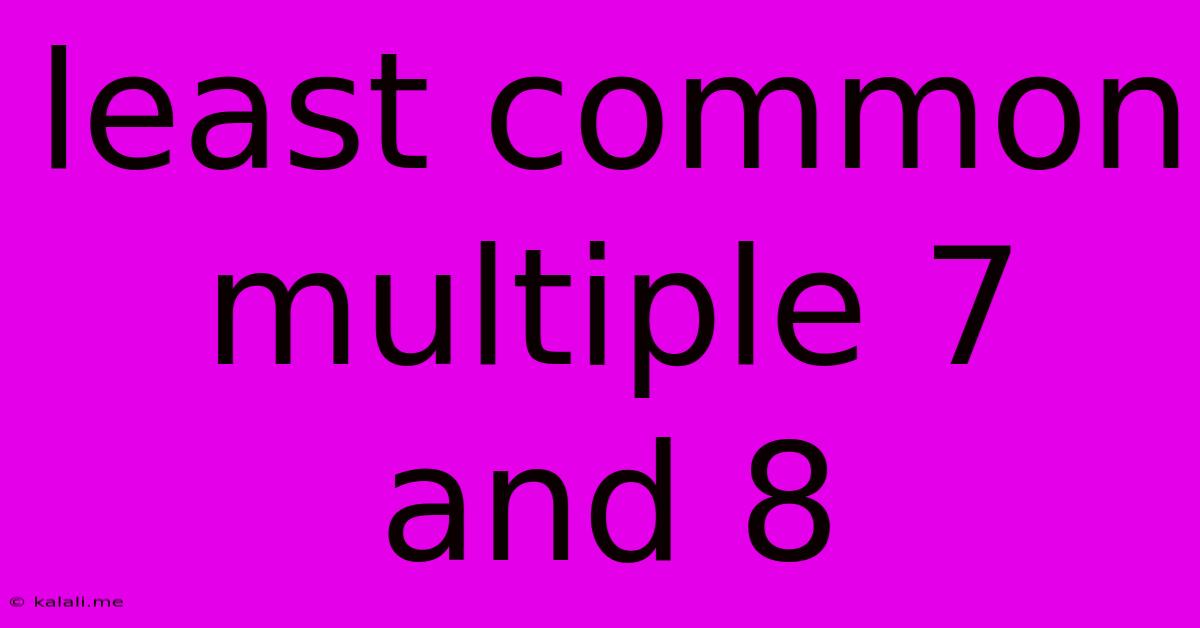Least Common Multiple 7 And 8
Kalali
May 10, 2025 · 3 min read

Table of Contents
Finding the Least Common Multiple (LCM) of 7 and 8
Finding the least common multiple (LCM) of two numbers is a fundamental concept in mathematics, crucial for various applications ranging from simplifying fractions to solving problems involving cyclical events. This article will guide you through the process of calculating the LCM of 7 and 8, explaining different methods and highlighting the underlying principles. Understanding LCMs is beneficial for students and anyone working with numbers and proportions.
What is the Least Common Multiple (LCM)?
The least common multiple (LCM) of two or more integers is the smallest positive integer that is divisible by all the integers. In simpler terms, it's the smallest number that contains all the numbers as factors. For example, the LCM of 2 and 3 is 6, because 6 is the smallest number divisible by both 2 and 3.
Methods for Finding the LCM of 7 and 8
There are several ways to find the LCM of 7 and 8. Let's explore two common methods:
1. Listing Multiples Method
This method involves listing the multiples of each number until you find the smallest multiple that is common to both.
- Multiples of 7: 7, 14, 21, 28, 35, 42, 49, 56, 63, 70...
- Multiples of 8: 8, 16, 24, 32, 40, 48, 56, 64, 72, 80...
Notice that the smallest number appearing in both lists is 56. Therefore, the LCM of 7 and 8 is 56. This method is straightforward for smaller numbers but becomes less efficient with larger numbers.
2. Prime Factorization Method
This method is more efficient, especially for larger numbers. It involves finding the prime factorization of each number and then constructing the LCM using the highest powers of all prime factors present.
- Prime factorization of 7: 7 (7 is a prime number)
- Prime factorization of 8: 2³ (8 = 2 x 2 x 2)
Since 7 and 8 share no common prime factors, the LCM is simply the product of their prime factorizations: 7 x 2³ = 7 x 8 = 56. This method provides a more systematic and efficient approach compared to listing multiples.
Understanding the Result: LCM(7, 8) = 56
The least common multiple of 7 and 8 is 56. This means that 56 is the smallest positive integer that is divisible by both 7 and 8 without leaving a remainder. This fact is crucial in various mathematical operations and problem-solving scenarios.
Applications of LCM
Understanding LCMs has practical applications in several areas:
- Fraction addition and subtraction: Finding a common denominator when adding or subtracting fractions.
- Scheduling problems: Determining when events will occur simultaneously (e.g., two buses arriving at the same stop at the same time).
- Cyclic patterns: Analyzing repeating patterns or cycles in various contexts.
In conclusion, the LCM of 7 and 8 is 56. By understanding the different methods for calculating the LCM, you can efficiently solve problems involving multiples and find solutions in various mathematical and real-world scenarios. Mastering the concept of LCM is a valuable skill for anyone working with numbers and their relationships.
Latest Posts
Latest Posts
-
How To Find The Product Of A Fraction
May 10, 2025
-
What Is The Freezing Point Of Gasoline
May 10, 2025
-
What Is 27 Out Of 40 As A Percentage
May 10, 2025
-
Lowest Common Multiple Of 4 6 And 8
May 10, 2025
-
23 Centimeters Is How Many Inches
May 10, 2025
Related Post
Thank you for visiting our website which covers about Least Common Multiple 7 And 8 . We hope the information provided has been useful to you. Feel free to contact us if you have any questions or need further assistance. See you next time and don't miss to bookmark.